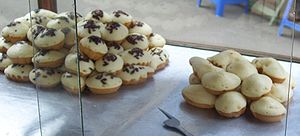INDONESIAN SNACK FOOD
INDONESIAN SNACK FOOD
KOLAK
 Kolak or Kolek is an Indonesian dessert made with palm sugar and coconut milk, with pandanus leaf (P. amaryllifolius) for flavour. In some versions, mung beans are also used, and cooked till soft. Banana may be added to this base, the dish then being known as kolek pisang. Pumpkin, sweet potato, jackfruit, plantain and/or cassava, and sometimes pearl tapioca may also be added. It is served either hot (especially if freshly cooked) or cold. Kolak is popular during the holy month of Ramadan, and is usually served cold during Iftar.
Kolak or Kolek is an Indonesian dessert made with palm sugar and coconut milk, with pandanus leaf (P. amaryllifolius) for flavour. In some versions, mung beans are also used, and cooked till soft. Banana may be added to this base, the dish then being known as kolek pisang. Pumpkin, sweet potato, jackfruit, plantain and/or cassava, and sometimes pearl tapioca may also be added. It is served either hot (especially if freshly cooked) or cold. Kolak is popular during the holy month of Ramadan, and is usually served cold during Iftar.
 SERABI
SERABI
Serabi, surabi or called srabi is an Indonesian pancake that is made from rice flour with coconut milk or just plain shredded coconut as an emulsifier. Each province in Indonesia has various serabi recipes corresponding to local tastes .
LEMPER
 Lemper (sometimes lemper ayam) is an Indonesian dish made of sticky rice filled with chicken, fish or abon (meat floss). The meat fillings is rolled inside the rice, in a fashion similar to an egg roll; this is in turn rolled and wrapped inside a banana leaf or tinfoil to make a packet ready for serving. Lemper are most often seen as snacks, but may sometimes be served as appetizers as well.
Lemper (sometimes lemper ayam) is an Indonesian dish made of sticky rice filled with chicken, fish or abon (meat floss). The meat fillings is rolled inside the rice, in a fashion similar to an egg roll; this is in turn rolled and wrapped inside a banana leaf or tinfoil to make a packet ready for serving. Lemper are most often seen as snacks, but may sometimes be served as appetizers as well.
LUPIS
 Lupis (sometimes lopis) is a traditional food from Indonesia. It is a sweet cake made of glutinous rice topped with shredded coconut and a thick palm sugar syrup. It is often found in traditional markets throughout Indonesia. Usually eaten as a breakfast or side dish in the evening tea time, it can be sweetened further with shredded coconut topped with a thick palm sugar syrup.
Lupis (sometimes lopis) is a traditional food from Indonesia. It is a sweet cake made of glutinous rice topped with shredded coconut and a thick palm sugar syrup. It is often found in traditional markets throughout Indonesia. Usually eaten as a breakfast or side dish in the evening tea time, it can be sweetened further with shredded coconut topped with a thick palm sugar syrup.
Lupis commonly found in Javanese area, especially in the middle and eastern of Java
DODOL

In muslim majority countries such as Indonesia and Malaysia, dodol is commonly served during festivals such as Eid ul-Fitr and Eid al-Adha as sweet treats for children. The town of Garut in West Java is the main production center of dodol in Indonesia. There are many flavours of dodol available including a durian flavor, which is called "lempuk" available in Asian food stores. In Malaysia, its is quite popular amongst the eastern states such Kelantan and Terengganu, while in Indonesia durian dodol is popular in Medan and other Sumatran cities.
Dodol has also made its way to some middle eastern countries including Iran, where it is very common and normally preferred by women. Though Dodol is proven to be fattening, it is used as a facemask and skin mask by some.
KUE CUBIT
 Kue cubit is a common snack food in many Indonesian cities. It is a cake, around 4 centimetres (1.6 in) in diameter. It can be found around the school by street sellers. Kue cubit uses flour, baking powder, sugar and milk as their primary ingredients. The liquid dough is poured inside a steel plate with several small round basins so that it will form round shape when cooked, and poured with meises (chocolate granule) on top of it. The seller uses some kind of special hooked stick to take the cake off from the steel plate.
Kue cubit is a common snack food in many Indonesian cities. It is a cake, around 4 centimetres (1.6 in) in diameter. It can be found around the school by street sellers. Kue cubit uses flour, baking powder, sugar and milk as their primary ingredients. The liquid dough is poured inside a steel plate with several small round basins so that it will form round shape when cooked, and poured with meises (chocolate granule) on top of it. The seller uses some kind of special hooked stick to take the cake off from the steel plate.
This cake is called kue "cubit" (Indonesian: pinch) because of its small bite size, to eat it one have to pinch it. Another varient is called kue "laba-laba" (Indonesian: spider) refer to its spider web-like form that created through pouring the liquid dough spreaded around the steel plate and still connected. This cake is related to Dutch poffertjes.
TAPAI

http://en.wikipedia.org/wiki/Category:Indonesian_snack_foods













0 komentar:
Posting Komentar